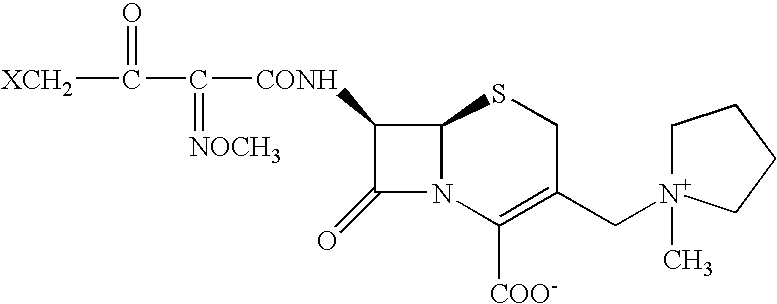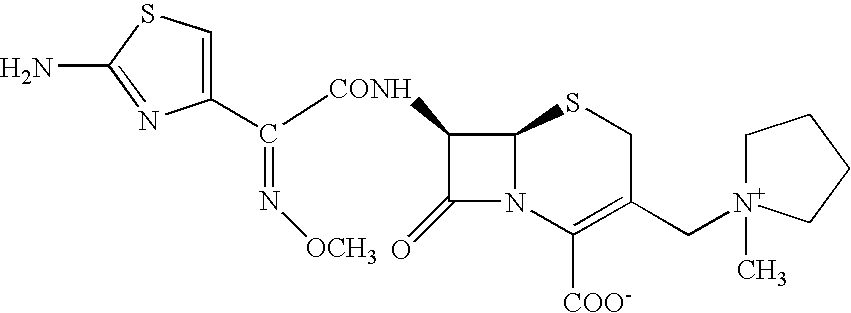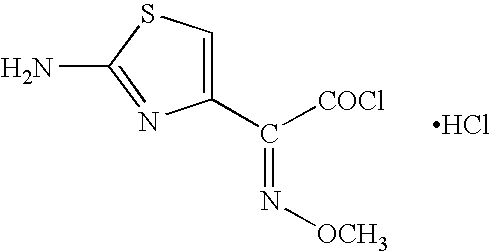Process for preparing cefepime
a cefepime and process technology, applied in the field of cefepime preparation, can solve the problems of unpractical manufacturing of purification methods and report yet to da
- Summary
- Abstract
- Description
- Claims
- Application Information
AI Technical Summary
Problems solved by technology
Method used
Image
Examples
example-1
Stage-I:
Step-A: Silylation of 7-AMINO-3-[(1-METHYL-1PYRROLIDINIUM)METHYL]-3-CEPHEM-4-CARBOXYLATE HYDROCHLORIDE (Solution A)
To a suspension of 7-amino-3-[(1-methyl-1-pyrrolidinium)methyl]-3-cephem-4-carboxylate hydrochloride (10 g, 0.03 mol) in methylene chloride (100 ml) at 20-25° C., N-trimethylsilylacetamide solution (containing 26.72 g N-trimethylsilylacetamide, 0.20 mol) was added and stirred for 1 hour to obtain a clear solution. This solution was cooled to −25° C. to −20° C. until use.
Step-B: Preparation of 4-BROMO-2-METHOXYIMINO-3 OXOBUTYRYLCHLORIDE (Solution B)
To a suspension of phosphorous pentachloride (7.5 g; 0.036 mol) in methylene chloride (62 ml), 4-bromo-2-methoxyimino-3-oxobutyric acid (7.73 g, 0.035 mol) was added in small lots over a period of 10 minutes, while maintaining the temperature between −25° C. and −20° C. The reaction mass was stirred at −25° C. to −20° C. until the starting material's absence was noted with TLC (30 minutes). The reaction mass w...
example-2
Stage-I:
Preparation of 7-(4-CHLORO-2-METHOXYIMINO-3-OXOBUTYRAMIDO)-3-[(1-METHYL-1-PYRROLIDINIUM)METHYL]-3-CEPHEM-4-CARBOXYLATE (Chloro Intermediate)
4-Chloro-2-methoxyimino-3-oxobutyric acid (6.2 g, 0.0345 mol) was added to a suspension of phosphorous pentachloride (7.5 g, 0.0360 mol) in methylene chloride (62 ml) in small lots over a period of 10 minutes while maintaining temperature between −25° C. and −20° C. The reaction mass was stirred at −25° C. to −20° C. until completion of the reaction (˜1 hour) and then washed with cold water (23 ml, 5° C.). The resulting acid chloride is reacted with silyalted 7-amino-3-[(1-methyl-1-pyrrolidinium)methyl]-3-cephem-4-carboxylate hydrochloride as per the procedure given in Example-1 to obtain the chloro intermediate as its hydrochloride salt. The structure of this compound was confirmed by spectroscopic data.
1H NMR (300 MHz) (DMSO-d6) δ: 2.11 (m, 4H), 2.94 (s, 3H), 3.45 (m, 1H), 3.60 (m, 3H), 3.68 & 4.06 (2d, each 1H), 4.05 (s, 3H), 4....
PUM
| Property | Measurement | Unit |
|---|---|---|
| purity | aaaaa | aaaaa |
Abstract
Description
Claims
Application Information
 Login to View More
Login to View More - R&D
- Intellectual Property
- Life Sciences
- Materials
- Tech Scout
- Unparalleled Data Quality
- Higher Quality Content
- 60% Fewer Hallucinations
Browse by: Latest US Patents, China's latest patents, Technical Efficacy Thesaurus, Application Domain, Technology Topic, Popular Technical Reports.
© 2025 PatSnap. All rights reserved.Legal|Privacy policy|Modern Slavery Act Transparency Statement|Sitemap|About US| Contact US: help@patsnap.com



